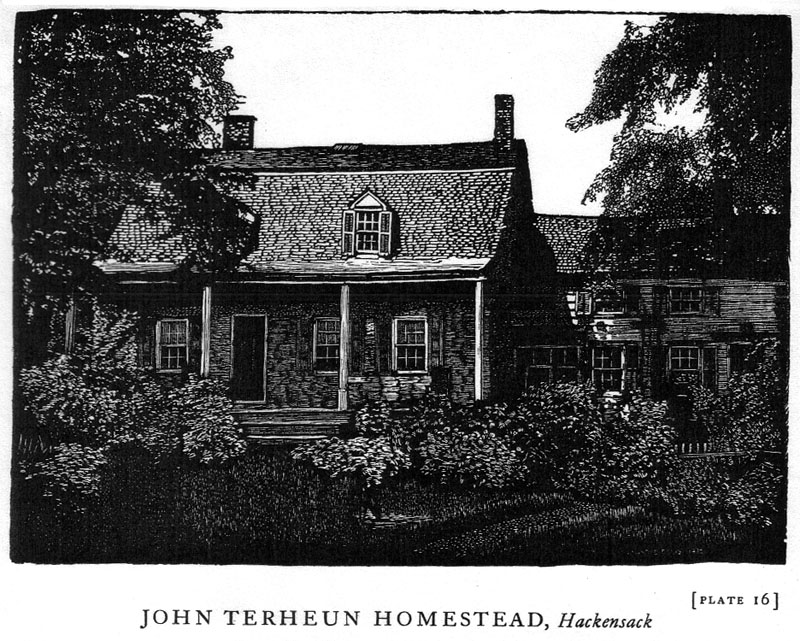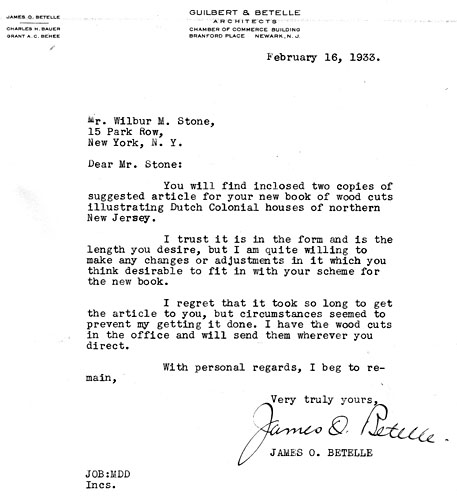 James Betelle wrote articles for countless magazines and journals, but as far as I know, only one book; a forward to a 1933 publication by The Carteret Book Club entitled Colonial Dutch Houses in New Jersey. I suspected the book was rare, as it could only be found in by-appointment collections; no open stacks or reference desks. One such collection is at The Grolier Club, conveniently located a few blocks from my apartment. I recently made an appointment to see the book.
James Betelle wrote articles for countless magazines and journals, but as far as I know, only one book; a forward to a 1933 publication by The Carteret Book Club entitled Colonial Dutch Houses in New Jersey. I suspected the book was rare, as it could only be found in by-appointment collections; no open stacks or reference desks. One such collection is at The Grolier Club, conveniently located a few blocks from my apartment. I recently made an appointment to see the book.
The Grolier Club is a beautiful old federal-style building squeezed almost anonymously among the noise, scaffolds and post-war apartments off Park Avenue. Upon entering, a gentleman at the front desk directed me to an elevator and the main reading room on the third floor.
 The room was empty, save for the expectant librarian. He sat me down in a creaky old chair at a creaky old table. After filling out a form, he went to fetch the book. I took a moment to take in the room; it was tall and long, with stacks of books on old shelves, a catwalk, and the musty warmth of an old but well used library.
The room was empty, save for the expectant librarian. He sat me down in a creaky old chair at a creaky old table. After filling out a form, he went to fetch the book. I took a moment to take in the room; it was tall and long, with stacks of books on old shelves, a catwalk, and the musty warmth of an old but well used library.
The book was handsome; it had a custom slipcase and end-papers, and was printed on heavy, creamy, rough-edged paper. The ink was blacker than black, feeling like part of the fibers themselves. It was in excellent condition; it was gifted to the club at the time of printing, and the librarian ruminated I was probably only the second or third person to look at it. Only 150 copies of the book were produced; indeed rare. At a price of $25, it was quite expensive for the time.
After about twenty minutes of reading Betelle’s text and leafing through the prints, I felt I had learned all I would. As I prepared to leave, the Librarian, almost offhandedly, mentioned that the Grolier Club had absorbed a large portion of the Carteret Club’s records after it dissolved in 1957. I stopped in my tracks. I wondered–if they had the Club’s papers, might they have something on Betelle? Sure enough, they had two folders of material pertaining to the book–including letters to and from Betelle.
These papers painted an interesting picture of the creation of the book; newspaper clippings, budget issues, typeface choices, maps and technical issues regarding the prints. According to one note, Betelle was enlisted to write the forward due to his architectural expertise and familiarity with New Jersey, but also, conveniently, because he was a member of the club.
 The letters between Betelle and the Carteret Book Club were a great discovery; I’ve been given a number of his letters via photocopies, but this was the first time I handled originals. I felt just a bit closer to the man himself now. Factually they’re significant because they lay out his whereabouts for a certain period of time, traveling “out west” for about three months. This has helped me a fair bit with the timeline of his life.
The letters between Betelle and the Carteret Book Club were a great discovery; I’ve been given a number of his letters via photocopies, but this was the first time I handled originals. I felt just a bit closer to the man himself now. Factually they’re significant because they lay out his whereabouts for a certain period of time, traveling “out west” for about three months. This has helped me a fair bit with the timeline of his life.
After copying a selection of items, I was satisfied with my visit. The book itself held no major surprises or insights regarding Betelle, nor did I think it would. But it was the unexpected discovery of the small cache of letters that made the trip really worth it.
The end of Betelle’s forward is in regards to the Dutch houses, but I think it could be equally applicable to his own works:
“It is a cause for pride and joy to the citizens of New Jersey that so many of these old homesteads are still standing, and that so many of them have been preserved and restored to their original character, and are being lived in either by the descendants of the original owners, or by someone who values and enjoys these houses of an early generation, which meant so much in the settlement and traditions of our country.”
Thanks go to The Grolier Club for permission to reprint items from their Carteret Book Club Collection.

